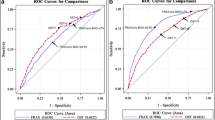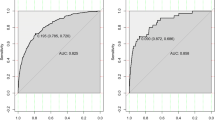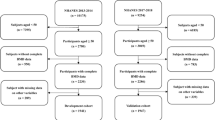Abstract
Several osteoporosis risk instruments have been proposed to select women for bone densitometry, but no validated instruments are currently available for men. This study aims to address this deficiency by developing and validating a Male Osteoporosis Screening Tool (MOST) for Chinese men. Two thousand ambulatory men, aged 65 and above, were recruited from the general community in Hong Kong, and a cohort of 1,970 men with valid total hip and lumbar spine dual-energy X-ray absorptiometry (DXA) measurements was included in the current analysis. A 60% random sample was selected as the training sample for developing the screening tool, and the remaining 40% constituted the validation sample. Logistic regression and receiver operating characteristic (ROC) analysis were used to identify the simplest combination of risk factors to be included in the screening tool for predicting osteoporosis at the femoral neck, total hip, or lumbar spine. Body weight and quantitative ultrasound index (QUI) were found to contribute significantly to the area under the ROC curve (AUC), yielding an AUC of 0.823 in the training sample. The resulting MOST had a sensitivity of 94% and a specificity of 46% when using a cutoff score of 3. MOST had an AUC of 0.839 in the validation sample. The risk of osteoporosis was 1% among those with MOST scores ≤2, but 72% among those with MOST scores >7. Using a cutoff of 3, the negative predictive value was 97.5% which suggests that the 42% with MOST scores ≤3 may be accurately screened out as being without osteoporosis, thus saving two fifths of our DXA resources. The positive predictive value was 72% when using a cutoff of 7, implying that MOST cannot replace DXA for case-finding purposes. Nevertheless, for resource allocation and patient satisfaction, it is prudent and economical to offer DXA screening first to the 6% with MOST scores >7.



Similar content being viewed by others
References
Riggs BL, Melton LJ (1995) The worldwide problem of osteoporosis: insights afforded by epidemiology. Bone 17:S505–S511
Melton LJ, Chrischilles EA, Cooper C, Lane AW, Riggs BL (1992) Perspective: how many women have osteoporosis? J Bone Miner Res 7:1005–1010
Cooper C, Campion G, Melton LJ (1992) Hip fractures in the elderly: a world-wide projection. Osteoporos Int 2:285–289
Lippuner K, von Overbeck J, Perrelet R, Bosshard H, Jaeger P. Incidence and direct medical costs of hospitalizations due to osteoporotic fractures in Switzerland. Osteoporos Int 1997;7:414–425
National Osteoporosis Foundation (1998) Osteoporosis: review of the evidence for prevention, diagnosis, and treatment and cost-effectiveness analysis. Osteoporos Int 8:S7–S80
Brown JP, Josse RJ for the Scientific Advisory Council, Osteoporosis Society of Canada (2002) 2002 clinical guidelines for the diagnosis and management of osteoporosis in CMAJ 167:S1–S34
Kanis JA, Delmas P, Buckhardt P, Cooper C, Torgerson D (1997) Guidelines for diagnosis and management of osteoporosis. The European Foundation for Osteoporosis and Bone Disease. Osteoporos Int 7(4):390–406
Meunier PJ, Delmas PD, Eastell R, McClung MR, Papapoulos S, Rizzoli R, Seeman E, Wasnich RD (1999) Diagnosis and management of osteoporosis in postmenopausal women: clinical guidelines. International Committee for Osteoporosis Clinical Guidelines. Clin Ther 21(6):1025–1044
Campion JM, Maricic MJ (2003) Osteoporosis in men. Am Fam Physician 67(7):1521–1526
Lydick E, Cook K, Turpin J, Melton M, Stine R, Byrnes C (1998) Development and validation of a simple questionnaire to facilitate identification of women likely to have low bone density. Am J Manag Care 4(1):37–48
Koh LK, Sedrine WB, Torralba TP, Kung A, Fujiwara S, Chan SP, Huang QR, Rajatanavin R, Tsai KS, Park HM, Reginster JY (2001) A simple tool to identify Asian women at increased risk of osteoporosis. Osteoporosis Self-Assessment Tool for Asians (OSTA) Research Group. Osteoporos Int 12(8):699–705
Cadarette SM, Jaglal SB, Kreiger N, McIsaac WJ, Darlington GA, Tu JV (2000) Development and validation of the Osteoporosis Risk Assessment Instrument to facilitate selection of women for bone densitometry. CMAJ 162(9):1289–1294
Hadji P, Hars O, Wüster C et al (1999) Stiffness index identifies patients with osteoporotic fractures better than ultrasound velocity or attenuation alone. Maturitas 31:221–226
Mikhail MB, Flaster E, Aloia JF (1999) Stiffness in discrimination of patients with vertebral fractures. Osteoporos Int 9:24–28
Pepe MS (2000) Receiver operating characteristic methodology. J Am Stat Assoc 95:308–311
Looker AC, Orwoll ES, Johnston CC Jr et al (1997) Prevalence of low femoral bone density in older US adults from NHANES III. J Bone Miner Res 12:1761–1768
Tenenhouse A, Joseph L, Kreiger N et al (2000) Estimation of the prevalence of low bone density in Canadian women and men using a population-specific DXA reference standard: the Canadian Multicentre Osteoporosis Study (CaMos). Osteoporos Int 11:897–904
Chan WP, Liu JF, Chi WL (2004) Evaluation of bone mineral density of the lumbar spine and proximal femur in population-based routine health examinations of healthy Asians. Acta Radiologica 45:59–64
Cadarette SM, Jaglal SB, Murray TM, McIsaac WJ, Joseph L, Brown JP (2001) Canadian Multicentre Osteoporosis Study: evaluation of decision rules for referring women for bone densitometry by dual-energy X-ray absorptiometry. JAMA 286(1):57–63
Cadarette SM, McIsaac WJ, Hawker GA, Jaakkimainen L, Culbert A, Zarifa G, Ola E, Jaglal SB (2004) The validity of decision rules for selecting women with primary osteoporosis for bone mineral density testing. Osteoporos Int 16(5):361–366
Adler RA, Tran MT, Petkov VI (2003) Performance of the Osteoporosis Self-assessment Screening Tool for osteoporosis in American men. Mayo Clin Proc 78(6):723–727
Khaw KT, Reeve J, Luben R, Bingham S, Welch A, Wareham N, Oakes S, Day N (2004) Prediction of total and hip fracture risk in men and women by quantitative ultrasound of the calcaneus: EPIC-Norfolk prospective population study. Lancet 363(9404):197–202
Bauer DC, Gluer CC, Cauley JA, Vogt TM, Ensrud KE, Genant HK, Black DM (1997) Broadband ultrasound attenuation predicts fractures strongly and independently of densitometry in older women: a prospective study. Study of Osteoporotic Fractures Research Group. Arch Intern Med 157(6):629–634
Frost ML, Blake GM, Fogelman I (2000) Can the WHO criteria for diagnosing osteoporosis be applied to calcaneal quantitative ultrasound? Osteoporos Int 11(4):321–330
Forsen L, Sogaard AJ, Meyer HE, Edna T, Kopjar B (1999) Survival after hip fracture: short- and long-term excess mortality according to age and gender. Osteoporos Int 10(1):73–78
Adler RA, Funkhouser HL, Petkov VI, Elmore BL, Via PS, McMurtry CT, Adera T (2003) Osteoporosis in pulmonary clinic patients: does point-of-care screening predict central dual-energy X-ray absorptiometry? Chest 123(6):2012–2018
Dargent-Molina P, Piault S, Breart G (2003) A comparison of different screening strategies to identify elderly women at high risk of hip fracture: results from the EPIDOS prospective study. Osteoporos Int 14(12):969–977
Hui Y (2002) Osteoporosis: should there be a screening programme in Hong Kong? Hong Kong Med J 8(4):270–277
Acknowledgements
This work was partially supported by the Research Grants Council Earmarked Grant CUHK4101/02 M and the National Institutes of Health R01 grant AR049439–01A1. The authors wish to thank all the participants for their dedicated contribution to the study.
Author information
Authors and Affiliations
Corresponding author
Rights and permissions
About this article
Cite this article
Lynn, H.S., Lau, E.M.C., Wong, S.Y.S. et al. An osteoporosis screening tool for Chinese men. Osteoporos Int 16, 829–834 (2005). https://doi.org/10.1007/s00198-004-1768-1
Received:
Accepted:
Published:
Issue Date:
DOI: https://doi.org/10.1007/s00198-004-1768-1




